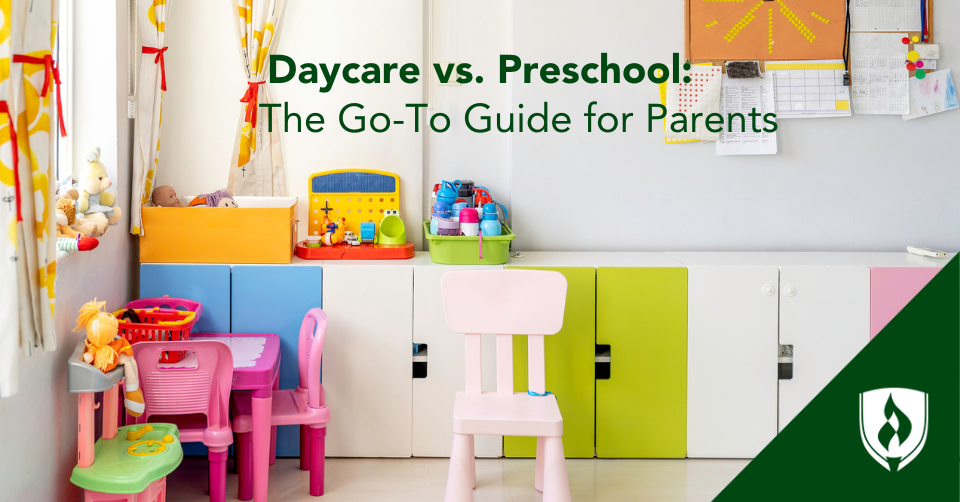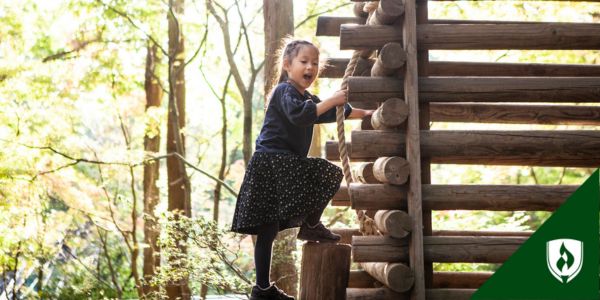
The terms daycare and preschool are sometimes used interchangeably, but they're not the same.
There are certainly similarities—both are forms of early childhood education (ECE), and both provide child care for young children. In fact, a good preschool and a good daycare program may actually end up having a lot in common.
While every industry has its terms that get easily confused or overlapped, the titles daycare and preschool do tend to mean different things.
On this page, we’ll break down some of the key differences between daycare vs. preschool, helping you determine which child care program may be best for you at the different stages of your little one’s life.
Daycare vs. preschool: age groups and requirements
One of the most basic differences between daycare and preschool starts with your child's age and the different limitations for each program. In general, daycare offers mixed-age care, typically from infancy through 6 years old (and maybe grade school options for summer care or before and after school hours).
Preschool tends to stand for the two to three years before kindergarten, serving kids between three and five years old. Preschools generally won’t accept kids younger than two, and children over six are usually moved up to kindergarten.
In contrast, daycare serves a wider age range. Many daycares have programs for younger children under two, including infants as young as six weeks old. This makes it a good option for young children who don't yet qualify for preschool but still require child care.
Daycare may serve older children as well. It's common for elementary school kids anywhere from five to 12 years old to attend daycare as a form of before or after school care.
Daycare vs. preschool: settings and locations
When it comes to settings, the differences in daycare vs. preschool really only exist on a center-by-center basis. Both depend on factors ranging from the program owner and the program goals to sources of funding, and whether the organization is public or private.
The settings for preschools, daycares and similar child care options can include private homes, places of worship, workplaces, elementary schools and beyond. Of course, larger daycare or preschool programs may also have their own dedicated buildings.
Given the variety of settings these early education facilities may be located in, it's important to keep an open mind. The type of building a preschool or daycare program is housed in does not determine whether or not it provides high quality child care. A better indicator of a program’s quality is in the teachers and caregivers it hires, since a child’s experience will depend greatly on their connection to the adults in the room.
To find child care programs and other local resources in your area, head to childcare.gov and input your location.
Daycare vs. preschool: hours and calendar schedules
This difference is a big one. For the most part, preschools are open during average school hours—roughly 8am to 3pm—and follow a standard public school schedule for breaks, holidays and summer vacations (though some may offer additional summer camp programs). Many preschools offer both half-day and full-day options as well.
On the other hand, daycare centers open earlier and close later to accommodate the schedules of working parents and caregivers—usually opening around 7am or 8am and closing around 6pm. Because of this, it’s not uncommon for children to spend a couple of hours at daycare before or after a day at preschool.
Daycares typically offer child care year round, and they tend to stay open on holidays and preschool breaks to provide caregivers and working parents with child care alternatives. Rather than stick to half-day or full-day schedules, daycare centers will often allow caregivers to customize their drop-offs and pick-ups based on their unique needs.
Daycare vs. preschool: day-to-day structures
Seeing as it follows typical school hours, preschool tends to be more like a school in its day-to-day structure. There may be designated blocks of time for lessons, playtime, naptime, lunch and more. While certain programs are more structured than others, education and school readiness are often a central component of preschool.
Children can begin to learn many important motor, cognitive and social skills at preschool, and it’s often seen as a stepping stone to prepare children for kindergarten. A robust preschool curriculum will aid in a child's development by introducing them to a classroom setting and laying a foundation for building pre-academic skills.
Daycare programs can certainly be deeply educational and intentional. Some daycares are even called “schools” and include training in child development for their teachers or tuition reimbursement options to encourage their staff to earn an Early Childhood Education degree or diploma.
But daycare options can also include arrangements that are more like babysitting, where caregivers keep children safe, but don’t intentionally engage them. As you research daycare options, ask the teachers or caregivers about how they work with the children, and if they use intentional teaching. Their answers might help you determine what kind of experience they are offering and what might be a good fit for your child.
While you are asking questions, see if you can come and visit any preschool or daycare you are considering. Pay attention to how teachers greet each child who comes in. Are they attentive? Do children interact with them? Do they kneel down and speak at eye-level for the children? Signs like these, and other things to watch for (recommended by childcare.gov) can help you find a nurturing environment for your child.
Daycare vs. preschool: potty training expectations
Some child care organizations have rules about if your child needs to be potty trained upon enrollment.
If you are wondering whether your kid needs to be potty trained for daycare vs. preschool, exact requirements are definitely program-specific. The general rule of thumb? Your child being potty trained might not be a prerequisite for daycare—especially given the different age groups they serve—but it may be expected or required for preschool.
Of course, different school programs and child care facilities will have different rules on whether their kids need to be potty trained—and everyone knows that accidents happen. If you're unsure or have more questions about potty training requirements, be sure to contact the daycare staff or preschool teachers at the centers near you for more information.
Daycare vs. preschool: pricing and federal funding
Cost tends to be one of the most important considerations when choosing daycare vs. preschool. On this subject, most of the determinants have to do with whether the program is part of the city or state's public school system. If it is—it’s likely to be a no-cost option for families. But since universal preschool hasn’t happened at a federal level yet, your area might not have the option.
As of the last few years, a handful of states and cities including Oklahoma, New York City and Washington, D.C. offer universal preschool starting at age three or four, according to the New York Times.
Free daycare for children below three or four is less common, though options for low-income families may exist depending on location.
Excluding the exception of public preschool, daycare and preschool costs in the United States vary substantially based on the type of child care provider, the quality of care provided, the age of children served and the geographic location of the provider.
Among preschool-aged children, center-based child care prices per child ranged from $6,239 in 2018 in small counties to $11,050 in very large counties. Home-based child care prices ranged from $5,541 in 2018 in small counties to $9,019 in very large counties, according to a report by the U.S. Department of Labor Women's Bureau.1
The same report showed that child care prices were consistently higher for infant care. The median yearly child care price for one child in center-based infant care ranged from $7,461 in 2018 in small counties to $15,417 in 2018 in very large counties.1
Among home-based providers, infant care ranged from $5,824 in 2018 in small counties to $9,892 in 2018 in very large counties.1
What do these numbers mean? Despite free programs in select areas, the cost of private preschools—and even more-so infant daycares—are high. Child care consumes a significant percentage of median family income across all care types, age groups and county population sizes—even for families incurring these costs for just one child. This reality is why lawmakers have discussed creating universal preschool legislation for quite some time.
Regardless of whether you’re in a state or city with public preschool, be sure to do your research on all of the child care options available to you. There may be opportunities for state or government-subsidized daycare or child care programs through vouchers, grants and more.
Choosing carefully to help your child thrive
Whether your child is six weeks old, toddling or gearing up for kindergarten, there’s no question about the importance of their brain development right now.
These early years lay the foundation they will build on for the rest of their lives. Early childhood educators who take their work seriously understand how critical this time is for little ones. Check out our article, "What to Look For in a Preschool: 7 Signs of High-Quality ECE".
For parents, it can be equally illuminating to see the staggering significance of these first five or six years. Check out “5 Reasons Why the Importance of ECE Is Impossible to Ignore” to get a better idea of why child care is so much more than keeping children safe and fed.
Rasmussen University Early Childhood Education programs do not prepare students for licensed teaching positions in any public school setting, but students will have the opportunity to help shape the futures of young children from birth to age six in a childcare or non-public school setting or leadership role.
Related Articles:
1Women’s Bureau U.S. Department of Labor, Issue Brief, Childcare Prices in Local Areas: Initial Findings from the National Database of Childcare Prices [Accessed June 2023] https://www.dol.gov/sites/dolgov/files/WB/NDCP/WB_IssueBrief-NDCP-final.pdf




